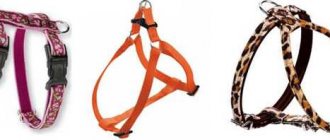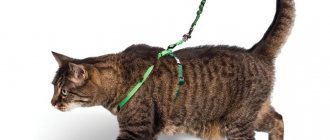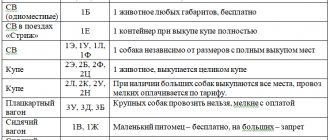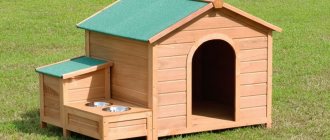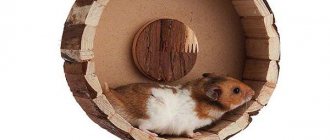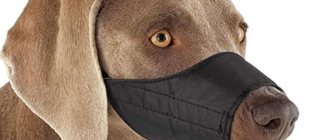Pets are mobile and active. By walking them on the street, the owner runs the risk of not being able to keep his pet and losing it. The right solution would be to put a harness on the dog. This accessory helps to securely secure the shoulders and chest without injuring or causing pain to the dog. The only difficulty that causes a lot of trouble is the process of getting used to the new harness, which is strange and unusual for the animal.
- 1 At what age should a dog wear a harness?
- 2 Mr. Tail recommends: step-by-step instructions (how to put a harness on a dog)
- 3 What is a harness
- 4 Harness or collar
- 5 Types of harnesses 5.1 By material
- 5.2 By purpose
What is a harness
A harness is a device consisting of belts, metal rings and fasteners that is used to control a dog's behavior. A leash is additionally attached to it.
The straps are positioned so as to wrap around the dog's chest, and sometimes around the croup. The main strap runs between the animal's front legs and is attached to the chest and circumference straps. The clasp is located in the withers area. There are also two rings attached for a leash, which is fastened with a special carabiner.
In this case, the main thing is that the dog’s neck remains free. Therefore, first of all, a harness is put on a dog whose neck has been damaged in some way - there has been surgery, there are tumors or wounds.
Sometimes it is easier for an animal owner to handle his dog with the help of a harness. After all, some pets manage to wriggle out of the collar and thus free themselves from the control of the owner.
Harnesses are worn by service dogs that are trained to rescue people. This accessory is necessary for sled dogs. During sports and strength training to develop muscles and various necessary skills, pets also wear them.
Harness or collar?
A collar is a very convenient accessory because it can be used to easily control a dog , especially a large breed. It is much easier to correct behavior by gently tugging on the leash when it is only attached to the dog's neck. The dog feels any movement of the leash much better in such a situation.
When a dog is wearing a harness, the load on the owner's hand increases significantly. Because in this case, the animal acts with its entire body, pulling the person behind it with much greater force. In addition, the pet does not feel the movement of the leash so much, so it will react worse to the owner’s attempts to calm it down.
The harness forces the dog to keep its neck parallel to the ground. In some breeds, for example, Jack Russell terriers, this provokes an incorrect neck position and an uneven distribution of the overall load on the dog’s body. This is fraught with further problems with the spine.
In some dogs, the elbows of the front legs are not pressed very close to the body. Wearing a harness in such a situation will make the situation even worse. This can lead to incorrect position of the paws, which can lead to problems with appearance and gait. And in the future, to some diseases of the musculoskeletal system.
The collar also has its drawbacks . The dog's neck is the most vulnerable place. Any discomfort in this place is perceived by the animal as a threat to life. Accordingly, the reaction to a strong tug on the leash attached to the collar can be very aggressive.
As a result of observations, it became known that most spinal diseases in dogs are the result of constantly wearing a collar. Strong tugging on the leash can lead to vision and hearing problems. The nervous system also suffers, because pressure in the throat area is a serious stress.
So, the best thing is to alternate wearing a harness and a collar in different situations . It all depends on the breed, size of the dog, its character and the capabilities of the owner.
As for dogs of different breeds, there are some nuances here. For example, short-necked breeds such as the French Bulldog and Pekingese will prefer to wear a harness.
For dogs of small breeds - Chihuahuas, Yorkies, Spitz, Toy Terriers, lapdogs, a harness is also better suited. Because these babies have a rather delicate skeletal system, a thin neck, which is very easy to damage.
Large breeds such as Labrador or German Shepherd will do well to be trained to wear both a harness and a leash.
The main thing is to teach the dog discipline, especially on the street. This applies to both large and small breeds. Because, knowing the command “near”, the dog will never provoke a situation that is traumatic for itself and the people around it.
Instructions on how to learn how to properly put a collar on your pet
It is necessary to put on the collar item in such a way that your angry dog cannot slip out of it during a walk. There are cases when a dog eats his collar, but it can also be observed due to the fact that it is not worn correctly.
If the puppy is not yet grown enough to wear his accessory, you should definitely make additional holes in the item. However, if there is a very long free edge left, it does not need to be left in this hanging position. It is best to secure the free end with an elastic band or other available fasteners.
If the dog has a habit of breaking free, you need to attach a special capsule to the collar, where your phone number and address will be indicated in case the harness breaks and the pet gets lost. Next, it is worth considering the need to use a strict collar and whether your pet is wearing it correctly. Thus, a strict object is most often used short-term during the period of active training.
It is necessary to accustom an animal to a collar gradually and at regular intervals.
As for the age of the pet, when you can start using such an item, it is usually five to six months. At first, the dog may bite or express its dissatisfaction in some other way. However, after a certain period of time, he will get used to the object and will clearly follow all the necessary commands.
If you do not have certain skills in training a dog using a strict collar, then it is better to first seek help from professionals. If everything is done correctly, the pet will very quickly get used to it and become obedient.
It is the one-time use of a sharp object in the form of spikes in a strict collar that works best on dogs than the constant tugging of its leather counterpart. Today, rigorous training is used in almost all types of dog training, just as effectively as it was several decades ago.
Types and types of harnesses
Depending on their purpose, harnesses come in the following types:
A harness for walking is a common accessory that is sometimes used every day when going outside with a dog. Its lock is located in the dog’s withers, as are the rings for attaching the leash. You can purchase such a harness at any pet store or even sew it yourself. They come in different sizes, both for very small dogs and puppies, and large breeds.
Harness-vest – it is used for small dogs. It fastens in front or on the sides. On the back, near the withers, a ring is sewn onto a strong synthetic tape for attaching a leash. Such vests are made for the cold season from durable and warm material with a lining. They protect the dog's lungs from colds. Summer vest harnesses are made of mesh material so that air can easily pass through. This accessory is especially convenient for pets of small breeds, since the soft material does not compress the chest and armpit area, and does not rub the skin. In one of the articles on our website you will find detailed instructions on how to sew a harness for a dog with your own hands, a master class with patterns.
From what age
The puppy has a rather fragile skeletal system, his muscles are not fully formed, he is growing and changing. Therefore, any improper load can cause irreparable damage. The limbs and chest will not form correctly.
Therefore, it is best to put a harness on a small breed dog for the first time at the age of 6 months. For large breeds this age ranges from 8 to 10 months. In this case, you will need to consult with a specialist to choose the appropriate ammunition.
For puppies, there are special harnesses made of soft, elastic materials and thin straps. They have fewer metal parts, are lightweight and at the same time durable.
When is clothing not needed?
Many owners dress their dogs up just because it is fashionable and stylish. But in some cases, clothing is just unnecessary and hinders the dog’s movements. For example, you should only dress a short-haired dog in late fall or winter. You should know that you should not wrap your dog in a raincoat at the first drops of rain, especially in summer. This frequent practice leads to disruption of the dog’s thermoregulation and also negatively affects the coat. And a few more tips:
Dressing an animal if the apartment is warm and dry is not the best idea.
Owners of large dog breeds, such as Malamutes, St. Bernards or Huskies, should forget about clothing. Their fur is designed to protect them from the cold. Therefore, they can “overheat” in clothes.
Decorative dogs should be dressed in warm overalls with fleece when the temperature drops below -5 degrees.
It is very important that overalls for a puppy or adult dog do not restrict movement, do not chafe and allow active running. You need to buy overalls for your dog taking into account the season, the dog’s gender and breed. Demi-season clothing protects from moisture and dirt, and overalls with a warm lining protect from frost. It is better to choose a store where clothes are made only from environmentally friendly materials. The dog owner must understand when clothing is necessary and when it is not. Of course, each dog has individual thermoregulation, but some breeds are not genetically adapted to cold temperatures, so it is important to keep them healthy.
How to choose the size
Size is very important, since a tight harness can cause various diseases and deformities of the paws. It will be difficult to hold a pet in too loose ammunition, since he can easily “wriggle out” of it.
An incorrect size will result in the sternum strap being too close to the armpit. And this is serious discomfort for the pet. The dog will try to avoid it by twisting its elbows. If you wear such a problematic harness all the time, then incorrect paw placement and gait are guaranteed. This is especially important for animals that are planned to be taken to exhibitions.
Is it possible to use a collar for puppies?
All dog handlers are clear on this – it’s impossible. Even if the puppy is a shepherd dog, Labrador, pit bull or another breed that requires careful attention from the owners. A strict collar is only worn on adult dogs.
Puppies can wear only these collars
A strict collar is a useful piece of equipment, but it is better to wear it under the supervision of a canine specialist. We must not forget that the main tools for training a dog are affection, attention and care, and punishment should be used only as a last resort.
For a small dog
Small breeds - Chihuahuas, toy terriers, Yorkies, dwarf dachshunds, Spitz dogs, lapdogs and other children - are suitable for mini-harnesses with thin, silky, but quite durable straps. Such accessories are practically no different in their configuration from those intended for large dogs. They are simply smaller in size, have bright colors and are made from more delicate materials.
However, such ammunition will be durable and the dog will not jump out of it. In addition to harnesses, and especially harnesses-vests for small breeds, a special handle can be sewn on the back. This is done so that in a dangerous situation you can easily pick up the pet in your arms or, say, carry it through a puddle that is too large.
For a big dog
Large animals need accessories that can withstand serious loads - heavy weight and jerking force. Therefore, we can recommend a leather model here. The metal parts must also be powerful and cast. You can’t save money here and buy something simple. Because the power of the animal is capable of bending even metal parts and breaking belts. As a result, at an inopportune or dangerous moment, the dog’s leash will fly off and the harness will fall apart. The consequences will be unpredictable.
For large individuals with a calm character, models of the same design as for small dogs are suitable. If the animal shows aggression or is a service animal, then a more durable model is needed, consisting of two circular belts covering the chest and croup, connected at the bottom between the paws and along the back with separate slings.
The leash is also attached to the withers.
Do dogs need to be dressed and why? All pros and cons
The problem of purchasing clothes for four-legged pets becomes more and more urgent with the onset of the autumn-winter period.
The use of special clothing causes a huge number of conflicting opinions. Some breeders are sure that their dog does not need such luxury and consider overalls and boots to be an obvious excess. And other owners adhere to the belief that clothing for their pets is an irreplaceable thing and with special love they select new wardrobe items.
Who is right and whose point of view is more relevant at the present time?
Content:
This is important: you should clearly understand that stylish clothes for a short-term going out and walking models for active recreation will be fundamentally different not only in cut, but also in the materials used.
Quality, quantity of fasteners and straps
When choosing an accessory, you need to pay attention first of all to the fittings. Plastic fasteners are suitable for a small dog. For large and well-fed individuals, exceptionally powerful fittings are required, preferably metal ones. Be sure to check the fittings for strength, pay attention to the fact that the rings are cast, solid, made of steel.
The more fasteners and fastenings, the stronger the harness. All parts should fit well together, snap easily and not unfasten when pulled. All belts must be adjustable in length.
An important point - all belts must be stitched and not glued together!
When trying on, check how the straps are positioned, whether they press, do not rub, do not interfere with the dog’s movement, and do not dig into the armpits.
Possible problems
The puppy constantly pulls on the leash
Every time the pet resists and does not want to go in the indicated direction and begins to pull on the leash, stop, but do not pull the dog. Let the pet understand that any attempts to go in the opposite direction from the owner end in nothing. Call your baby over and give him a treat; if you use this pattern constantly, the dog will soon wean itself off the habit of pulling on the leash.
The puppy does not want to go and demonstratively does not move
Use treats and your patience. As soon as the dog stops, move away from it a few steps and invite the puppy to come to you to take the treat. When your pet complies with the request, continue your walk. Only by remaining completely calm can you teach your puppy not only to walk on a leash, but also to enjoy walks.
Material
The cheapest harnesses are made from canvas. This is a good material, but it wears out quickly and takes too long to dry when wet.
TEST.TV: Harness or collar?
Leather always looks beautiful, even if it is artificial. However, in extreme situations this material wears out quickly. In water, the skin stretches, in cold or heat it quickly cracks. So accessories made from this material are preferable for exhibitions and various kinds of exhibition events, city walks in good weather. Keep in mind that dogs love to chew leather straps.
Universal material is nylon, nylon. It practically does not get wet, it can always be cleaned. It does not burst, does not become rough over time, and holds its shape well. The seams on nylon are always strong and tear extremely rarely. In general, the material is able to withstand enormous loads for years.
The only drawback of artificial materials is that in an animal prone to allergic skin reactions, unwanted manifestations are possible. However, this happens in isolated cases.
How to put a harness on a dog - step-by-step instructions
There are several proven methods, here are detailed instructions:
Regular harness. Method 1.
This method is more suitable for a large dog.
- Prepare the harness in advance, examine which side it should be put on, and understand its design. Test to see if the latches and lock work well.
- Carefully secure the dog - squat down a little, wrap your legs and knees around its body closer to its hind legs. If your pet is too active, you can even lie down lightly on its back.
- Hold the harness in your right hand, as if hugging the dog in the chest area.
- With your left hand, grab the animal’s left front paw and easily, without tension, try to lift it off the floor and bend it at the elbow.
- Quickly insert your paw into the hole on the left, between two circular straps and one cross strap that goes across the chest.
- Pull the harness higher to your chest and grab it with your left hand.
- Everything is repeated for the right paw. Take the dog’s right paw with your right hand and lift it above the floor, bending it at the elbow.
- Insert your paw into the other hole between the circular straps and the cross one for your right paw.
- Pull the harness higher and snap the lock onto the withers.
- Check the harness straps to see if they got twisted while getting dressed. Tighten or, on the contrary, loosen the straps using the clamps so that the dog is comfortable. Test to see if the lock is securely fastened.
- Attach the leash to the rings at the withers. Are you ready to go for a walk!
When to wear a collar
For service dogs, the collar is practically part of the body; they wear it constantly. For hunters, on the contrary, it is unnecessary - during a hunt, the collar can get caught on a branch, and then you will be exhausted looking for the stuck dog. As for ordinary pets, they need it primarily so that they have something to attach the leash to. Also, an address tag with the dog’s name and the owner’s contact information is often hung on the collar , so that if the dog is lost, the dog can always be returned home.
No matter how obedient your pet is, do not take him for a walk without the appropriate equipment. Walking your dog in the city without a collar or harness is extremely risky!
